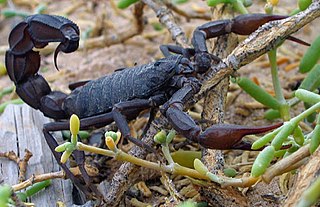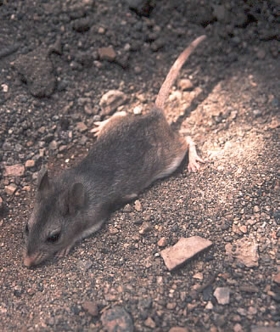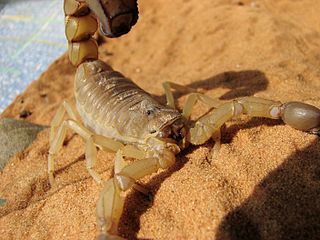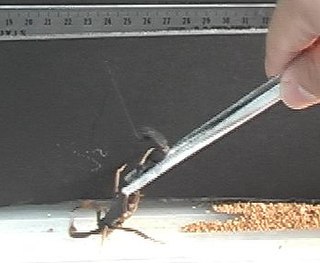
Scorpions are predatory arachnids of the order Scorpiones. They have eight legs and are easily recognized by a pair of grasping pincers and a narrow, segmented tail, often carried in a characteristic forward curve over the back and always ending with a stinger. The evolutionary history of scorpions goes back 435 million years. They mainly live in deserts but have adapted to a wide range of environmental conditions, and can be found on all continents except Antarctica. There are over 2,500 described species, with 22 extant (living) families recognized to date. Their taxonomy is being revised to account for 21st-century genomic studies.

Fattail scorpion or fat-tailed scorpion is the common name given to scorpions of the genus Androctonus, one of the most dangerous groups of scorpion species in the world. The genus was first described in 1828 by Christian Gottfried Ehrenberg.
Kurtoxin is a toxin found in the venom of the scorpion Parabuthus transvaalicus. It affects the gating of voltage-gated sodium channels and calcium channels.

The southern grasshopper mouse or scorpion mouse is a species of predatory rodent in the family Cricetidae, native to Mexico and the states of Arizona, California, Nevada, New Mexico, and Utah in the United States. Notable for its resistance to venom, it routinely preys on the highly venomous Arizona bark scorpion.

Hadogenes troglodytes is a species of scorpion from southern Africa. It is commonly known as the flat rock scorpion and commonly sold on the exotic pet market. It was once regarded as having the longest recorded body length of any scorpion, reaching up to 20 cm; however Heterometrus swammerdami currently holds the record for being the world's largest scorpion at 9 inches (23 cm) in length. May be confused with Hadogenes bicolor.
Birtoxin is a neurotoxin from the venom of the South African Spitting scorpion. By changing sodium channel activation, the toxin promotes spontaneous and repetitive firing much like pyrethroid insecticides do
Bestoxin is a neurotoxin from the venom of the South African spitting scorpion Parabuthus transvaalicus. Most likely, it targets sodium channel function, thus promoting spontaneous and repetitive neuronal firing. Following injection into mice, it causes non-lethal writhing behaviour.
Altitoxin is a neurotoxin found in the South African scorpion Parabuthus transvaalicus. Injection of altitoxin in mice leads to akinesia, depression and death.

Mesobuthus eupeus is a polymorphic scorpion species belonging to the well-known family Buthidae. Commonly known as the lesser Asian scorpion or the mottled scorpion. It is thought to be the most widely dispersed species of the genus Mesobuthus, perhaps even of the family Buthidae.
Dortoxin is a lethal peptide toxin which is secreted by the South African spitting scorpion Parabuthus transvaalicus. Injection of pure dortoxin in mice leads to hyperactivity that lasts until death.
Ikitoxin is a neurotoxin from the venom of the South African Spitting scorpion that targets voltage-sensitive sodium channels. It causes unprovoked jumps in mice following intracerebroventricular injections.

Androctonus crassicauda, the Arabian fat-tailed scorpion, is a species of extremely dangerous scorpion usually found in North Africa and the Middle East.

Androctonus bicolor, the black fat-tailed scorpion, is a scorpion species of the family Buthidae. It is black in color and can grow up to 8 cm. Black fat-tailed scorpions come from the family Buthidae, which is the largest of the scorpion family. They can be identified by their hefty physique. They tend to move very fast, and are of an aggressive nature. Black fat–tailed scorpions can live for up to 5 years. Adults can reach up to 40-60 millimeters, 80 millimeters being the maximum. These scorpions typically possess black and brown coloration. These scorpions enjoy making scrapes with wood and rocks, and are nocturnal, thus they hide in crevices or certain objects during the day. They stay in shade to retain moisture in their bodies, as they are susceptible to losing moisture due to their environmental preference.

Androctonus australis, the yellow fat-tailed scorpion, is a hardy desert scorpion from North Africa, Somaliland, the Middle East, Pakistan and India.

Parabuthus villosus, the black hairy thick-tailed scorpion, is a species of scorpion from southern Africa, where it ranges from the Northern Cape to Namibia. It is the largest species of the Buthidae, measuring up to 18 cm, and its diet may include lizards and mice. The species is often active at dawn and dusk, but takes refuge by day in a variety of shelters. It resembles Parabuthus transvaalicus, which is more strictly nocturnal, less hairy and with a more easterly distribution.

Parabuthus, commonly known as the thick-tailed scorpion, is a genus of large and highly venomous Afrotropical scorpions, that show a preference for areas of low rainfall. Their stings are medically important and human fatalities have been recorded.
Parabutoxin (PBTx) is a Shaker-related voltage-gated K+ channel (Kvα1) inhibitor purified from different Parabuthus scorpion species found in southern Africa. It occurs in different forms: parabutoxin 1 (PBTx1), parabutoxin 2 (PBTx2), parabutoxin 3 (PBTx3) and parabutoxin (PBTx10). The different variants have different affinities towards Kvα1 channels.

Parabuthus granulatus, commonly known as the granulated thick-tailed scorpion, a large species of scorpion from the drier parts of southern Africa. It measures some 11.5 cm, and is dark yellow to brown in colour. It has a relatively small vesicle, but is one of the more venomous scorpion species of the region. Of all scorpion species, it causes most of the serious cases of envenomation in South Africa, and a few people die each year from their sting.

Toxungen comprises a secretion or other body fluid of one or more biological toxins that is transferred by one animal to the external surface of another animal via a physical delivery mechanism. Toxungens can be delivered through spitting, spraying, or smearing. As one of three categories of biological toxins, toxungens can be distinguished from poisons, which are passively transferred via ingestion, inhalation, or absorption across the skin, and venoms, which are delivered through a wound generated by a bite, sting, or other such action. Toxungen use offers the evolutionary advantage of delivering toxins into the target's tissues without the need for physical contact.












